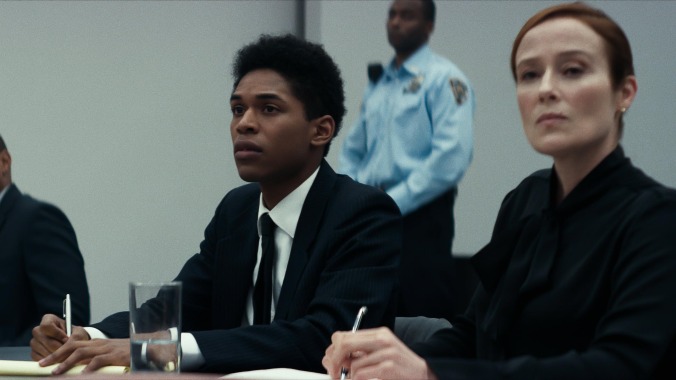We find Netflix’s Monster guilty of crimes against subtlety and nuance


Based on a popular young adult novel, Monster tells the sadly all-too-familiar story of a young Black kid caught up in the criminal justice system after being implicated in a crime he says he didn’t commit. Steve Harmon (Kelvin Harrison Jr.), a 17-year-old budding filmmaker who attends an elite high school far from his own Harlem neighborhood, faces life in prison after a bodega robbery involving some casual friends results in a murder. He’s snatched from his stable middle-class life and thrown into a world of lawyers and criminals, all of whom see him differently than he sees himself. There’s plenty of complexity to be mined from a scenario in which perception carries more weight than the truth, but director Anthony Mandler, a music video and commercial veteran making his feature debut, takes a broad-strokes approach to Steve’s plight. His prison experiences, his courtroom ordeal, and his generally upbeat life before his arrest are all captured in brief glimpses and glossy snapshots, neither of which serve such a difficult story well.
A palpable narrative and visual insecurity plagues Monster from the jump. Steve narrates his experiences before and after his arrest in diaristic voice-over, which pokes in the ribs more than it illuminates. (His voice-over also features some grating screenplay language, e.g., “Interior. Holding room. Day,” that the film mercifully abandons early on.) Much of the other dialogue is strictly on-task. Take the scenes with Steve’s film teacher (Tim Blake Nelson), who instructs him to find his story and uses Rashomon as an example of dueling perspectives—clumsy metaphors that hang over the rest of Monster.
Some of these issues can be chocked up to the inherent problems in adapting a fundamentally interior novel. But the superficial characterization of the supporting players betrays a general disregard for subtlety. The sensitive defense attorney (Jennifer Ehle), who warms up to Steve in record time, is “good,” while the callous prosecutor (Paul Ben-Victor), who literally points at Steve and bellows, “Monster!” in his opening statement, is “bad.” Only James King (Rakim Mayers, a.k.a. rapper A$AP Rocky), Steve’s friend from the neighborhood and one of the robbers, is afforded much complexity, in scenes where he alternately projects relaxed street charm and potential danger. Almost every other character remains trapped in trite dramatic binaries
These types of non-specific archetypes aren’t intrinsic liabilities, but they stand out like sore thumbs in a film specifically about not judging books by their covers. Every character in Monster remains basically who they are from the moment they’re introduced, especially Steve. “No one in that courtroom knows who I am!” he exclaims at one point, but no one here—Mandler, the film’s three screenwriters, or Harrison Jr.—builds the character out enough for the audience to know him either. He’s a normal, upstanding kid, seemingly liked by all and with a bright future ahead of him. That makes his suffering at the hands of an unforgiving legal system an obvious tragedy, but it doesn’t necessarily render him three-dimensional. A late “reveal” that slightly complicates Steve’s total innocence also isn’t substantial enough to count as shading.
Monster first premiered at the Sundance Film Festival in 2018 and was picked up for a fall 2019 theatrical release under a new title, All Rise. But that release plan came and went, and eventually, Netflix acquired distribution rights with plans to release the film under its original title, possibly to capitalize on the recent success of the film’s co-writer, Radha Blank (The Forty-Year-Old Version), and co-star, John David Washington (Tenet, Malcolm & Marie), who appears in three scenes and speaks in one. Sometime between its festival premiere and now, the film underwent a re-edit that shortened it by 14 minutes. These details are only relevant insofar as Monster, in its final form, frequently feels slapdash. Characters are often introduced haphazardly and without much justification, such as Steve’s girlfriend and a friendly convict played by Nas, both of whom speak in inanities and clichés, respectively, and don’t have enough screen time to be apportioned names. The prison scenes feel oddly compressed, while the courtroom sequences vacillate between leaden montages and a Law & Order-lite procedural. Other slice-of-life scenes in Steve’s neighborhood, presented in flashback, either don’t fascinate on their own or feel unintentionally random. A charitable reading would frame this approach as lyrical fragments designed to simulate the time-skipping process of memory. Unfortunately, it mostly reads as arrhythmic editing.
The performances in Monster are its sole selling point. Everyone acquits themselves reasonably well, especially Jennifer Hudson and Jeffrey Wright, who play Steve’s caring parents, with the latter delivering a monologue about his hopes for his son’s future that stands out as the film’s obvious highlight. Nevertheless, they’re hamstrung by overwrought, underdeveloped material, ill-served by a visual style that’s simultaneously showy and indistinct. It’s clear that Monster wants to spotlight the numerous inequities of the criminal justice system through a coming-of-age story—how a sympathetic child can be perceived as a threat in the context of a courtroom just because of his skin color. It’s a noble undertaking without question, but is stymied by a hyper-cursory approach. Monster, much like Modell from Diner, is uncomfortable with the word “nuance.” So, it settles for “gesture.”